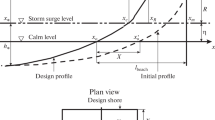Abstract
A model of an artificial beach is proposed for protecting a seacoast subjected to erosion under significant storm surge impact. The beach profile properties are based on the Dean equilibrium profile. It is shown that coarser sand yields a greater total beach width, but requires a greater volume of berm material. At the same time, this results in decreased loss of material to longshore sediment transport. The results of applying the model to three sectors of eroded coast in the Kurortny District of St. Petersburg (eastern Gulf of Finland) recommend the use of medium-grained 0.3–0.5 mm sand to construct the artificial beach. In this case, the width of the dry beach section would be about 80–140 m, while the volume of berm material would be (1.3–3.2) × 102 m3 per one meter of coast length depending on the sediment deficit for a given coastal sector. To minimize the relative loss of material, it is suggested to construct a beach no less than 1 km in length; in this case, more than half the initial beach volume would be retained even after 30 years. Modeling of extreme storm impact leads to the conclusion that the designed beach profiles are only slightly deformed and can retain their resources for many years.






Similar content being viewed by others
REFERENCES
L. K. Barkov, “Lithodynamic processes in the coastal zone of the eastern part of the Gulf of Finland from the Lautaranta Cape until Dubovsky Cape,” Izv. Vseross. Geogr. O-va 123 (1), 60–67 (1991).
I. O. Leont’yev, Coastal Dynamics: Waves, Currents, and Sediment Flows (GEOS, Moscow, 2001) [in Russian].
I. O. Leont’yev, “An estimate of the cross-shore sediment flux at the boundary of the coastal zone,” Oceanology (Engl. Transl.) 48, 123–128 (2008).
I. O. Leont’yev, Morphological Dynamics Processes in the Seashore Zone (LAP LAMBERT Academic, Saarbrücken, 2014) [in Russian]. ISBN 978-3-659-62831-3
I. O. Leont’yev, “Calculation of longshore sediment transport,” Oceanology (Engl. Transl.) 54, 205–211 (2014).
I. O. Leont’yev, D. V. Ryabchuk, and A. Y. Sergeev, “Modeling of storm-induced deformations of a sandy coast (based on the example of the eastern Gulf of Finland),” Oceanology (Engl. Transl.) 55, 131–141 (2015).
I. O. Leont’yev, D. V. Ryabchuk, A. Yu. Sergeev, and O. A. Kovaleva, “The forecast of coastal recession in the eastern gulf of Finland for the twenty-first century,” Oceanology (Engl. Transl.) 55, 434–440 (2015).
O. L. Rybak, “Submerged and coastal morphological structure,” in Humanity and Coastal Zone of the World Ocean in 21st Century (GEOS, Moscow, 2001), pp. 301–313.
D. V. Rybchuk, A. M. Kolesov, A. Yu. Sergeev, et al., “Abrasion processes in the coastal zone of the eastern part of the Gulf of Finland and their relation with long-term trends of regime-forming factors,” Geomorfologiya, No. 4, 99–105 (2012).
SP 32-103-97: Set of Rules on Engineering of Marine Coast-Protective Installations (Morskie Berega Scientific Research Center, Sochi, 1997) [in Russian].
A. Sh. Khabidov, I. O. Leont’yev, K. V. Marusin, et al., Coastal Control of Reservoirs (Siberian Branch, Russian Academy of Sciences, Novosibirsk, 2009) [in Russian].
R. G. Dean, “Equilibrium beach profiles: characteristics and applications,” J. Coastal Res. 7 (1), 53–84 (1991).
R. G. Dean, Beach Nourishment: Theory and Practice (World Scientific, Singapore, 2002).
I. A. Hunt, “Design of seawalls and breakwaters,” J. Waterw., Harbors Coastal Eng. Div., Am. Soc. Civ. Eng. 85, 123–152 (1959).
J. A. Jimenez and O. S. Madsen, “A simple formula to estimate settling velocity of natural sediments,” J. Waterw., Port, Coastal Ocean Div., Am. Soc. Civ. Eng. 129 (2), 70–78 (2003).
D. L. Kriebel, N. C. Kraus, and M. Larson, “Engineering methods for predicting beach profile response,” in Int. Conf. “Coastal Sediments’91” (Seattle, 1991), pp. 557–571.
T. Sunamura, “Sandy beach geomorphology elucidated by laboratory modeling,” in Applications in Coastal Modeling, Ed. by V. C. Lakhan and A. S. Trenhail (Elsevier, Amsterdam, 1989), pp. 159–213.
FUNDING
The study was financially supported by the Russian Foundation for Basic Research (project nos. 15-05-08239, 16-55-76002 ERA_a).
Author information
Authors and Affiliations
Corresponding author
Additional information
Translated by A. Carpenter
Rights and permissions
About this article
Cite this article
Leont’yev, I.O. Artificial Beach as a Structure for Protecting a Seacoast from Storm Surge Impact (Based on the Example of the Eastern Gulf of Finland). Oceanology 59, 267–275 (2019). https://doi.org/10.1134/S0001437019020115
Received:
Accepted:
Published:
Issue Date:
DOI: https://doi.org/10.1134/S0001437019020115




